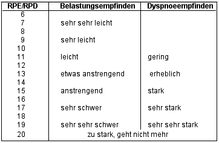Feeling of strain
The physical perception of stress is determined by very different structures and functions in the various forms of stress .
At maximum force load, maximum muscle tension is dominant; with sprint loads (longer than 10 s, e.g. 400 m) high lactate concentrations in the peripheral capillary blood (up to 25 mmol / L); in the case of very long endurance loads (e.g. marathon run ) the metabolic situation and central fatigue processes.
To evaluate the subjective perception of stress, the Swedish physiologist Gunnar Borg specified the Borg scale of RPE values ( R eceived P erception of E xertion) named after him . This was initially based on the exercise heart rate according to the equation: heart rate x 0.1 = RPE. This meant that a test person indicated his or her individual stress perception during an ergometry test; the indication slightly (10) z. B. at a heart rate of 100, the information is very difficult (17) at 170 heartbeats / min. Later, however, Borg also discovered that fatigue had many subjective psychological elements and took these into account. According to Per-Olof Åstrand's research , however, there is no causal relationship between the perceived and the real exposure. This was entirely in the Swedish tradition of natural training on the basis of the bio-psychosocial worldview, but contradicted the continental tradition, in which one looked for the most unambiguous biological connections. However, recent research shows that Borg correctly measured the biological effectiveness of the mind and predicted the relationships.
The modified scale also includes the respiratory distress experienced with increasing exertion , which is indicated by the RPD values ( R eceived P erception of D yspnea). In order to treat the individual perceptual variables objectively, Borg developed perceptometry as part of psychophysics .
literature
- Dickhuth, HH (ed.): Sports medicine. Ärzteverlag Cologne 2007. ISBN 978-3-7691-0472-1
Individual evidence
- ↑ However, the role of lactate in fatigue and stress is now being questioned, cf. about WAHL et al: Modern ways of looking at lactate: Lactate - an overestimated and at the same time underestimated molecule (PDF; 206 kB)
- ↑ BORG, G. (1982) Psychophysical bases of perceived exertion. Medicine and Science in Sports and Exercise 14 (5), pp. 377-381
- ^ Svensson, Daniel (2014): Changing tracks? The battle between natural and scientific training in Swedish cross-country skiing, 1948-1972. Idrott, historia och samhälle 34: 12-41; Arnd Krüger : Many roads lead to the Olympics. The changes in training systems for medium and long distance runners (1850–1997). In: N. Gissel (Hrsg.): Sporting performance in change. Czwalina, Hamburg 1998, pp. 41-56.
- ↑ sti, mut (2015): Positive expectation increases the effectiveness of the tablets. MMW - Advances in Medicine. June 2015, Volume 157, Issue 11, pp 29-29.
